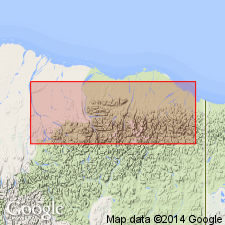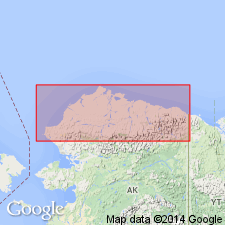
- Usage in publication:
-
- Sagwon Member*
- Modifications:
-
- Named
- Biostratigraphic dating
- Dominant lithology:
-
- Lignite
- Shale
- Siltstone
- Sandstone
- Conglomerate
- AAPG geologic province:
-
- Alaska Northern region
Summary:
Named as lowermost member (of 3) of Sagavanirktok Formation Type section designated as exposures from VABM Gard S for 1.6 km along river bluff [on west side of Sagavanirktok River, about 3 km northwest of Sagwon] 69 deg 23'30"N to 69 deg 24'30"N, 148 deg 39'30"W to 148 deg 41'W, northern AK. Westernmost occurrence is in White Hills about 32 km northwest of Sagwon. Consists of lignite and carbonaceous shale interbedded with clay shale and siltstone with massive sandstone and conglomerate in upper part. Is 143 m (470 ft) thick at type section. Conformably overlies Kogosukruk Tongue of Prince Creek Formation of Colville Group. Probably conformably underlies Franklin Bluffs Member (new) of Sagavanirktok Formation. Age is Paleocene and Eocene based on fossil flora collected near Sagwon.
Source: GNU records (USGS DDS-6; Menlo GNULEX).

- Usage in publication:
-
- Sagwon Member*
- Modifications:
-
- Revised
- Age modified
- Reference
- AAPG geologic province:
-
- Alaska Northern region
Summary:
Pg. 3-5 (figs. 2-4), 6-8 (table 1), 34-38. Sagwon Member of Sagavanirktok Formation. Restricted to upper part of Detterman and others' (1975) Sagwon Member at type section and area. As restricted, consists of a sequence of poorly consolidated, coarse-grained, clastic, fluvial sediments, approx. 75 to 100 feet thick, grading upward into finer grained sediments, probably up to 3,000 feet thick, that are commonly bentonitic and contain coal or lignite beds. Base of member marked by cliff-forming, white-weathering conglomerate and sandstone unit. The underlying predominantly brown-weathering, coal-bearing siltstones and mudstones ( = lower part of Detterman and others' Sagwon) are reassigned to Prince Creek Formation (revised). Age of Sagwon is considered late Paleocene, based on fossils (palynomorphs) obtained from the upper coal-bearing part of the member, northwest of Sagwon airstrip in the eastern White Hills (citing Frederiksen and others, 1996, USGS Open-File Rpt. OFR-96-84).
Reference sections:
(1) about 6 mi downstream from Sagwon airstrip in a vertical bluff on east side of Sagavanirktok River, in NE/4 sec. 18, T. 1 N., R. 15 E., [Sagavanirktok B-3 quadrangle, scale 1:63,360], northern AK;
(2) in a stream meander bluff of the Toolik River, in N/2 sec. 13, T. 1 S., R. 12 E., [Sagavanirktok B-4 quadrangle, scale 1:63,360], northern AK; and
(3) upper part of member exposed along west side of Toolik River, in E/2 sec. 1, T. 2 N., R. 12 E. to NW/4 sec. 6, T. 2 N., R. 13 E., [Sagavanirktok C-4 quadrangle, scale 1:63,360], northern AK.
Source: Publication.
For more information, please contact Nancy Stamm, Geologic Names Committee Secretary.
Asterisk (*) indicates published by U.S. Geological Survey authors.
"No current usage" (†) implies that a name has been abandoned or has fallen into disuse. Former usage and, if known, replacement name given in parentheses ( ).
Slash (/) indicates name conflicts with nomenclatural guidelines (CSN, 1933; ACSN, 1961, 1970; NACSN, 1983, 2005, 2021). May be explained within brackets ([ ]).

